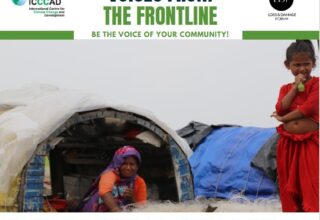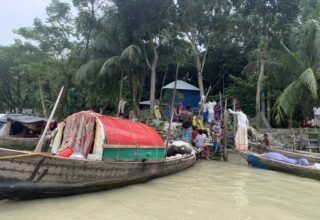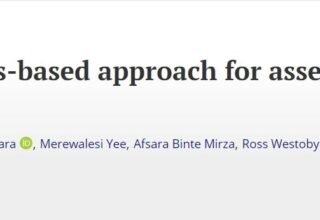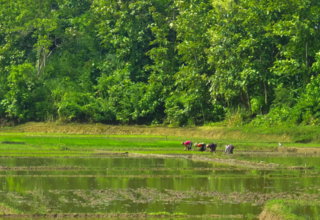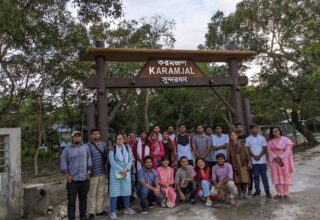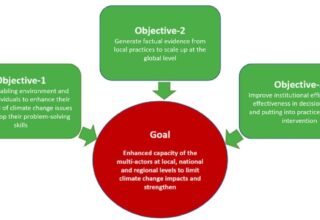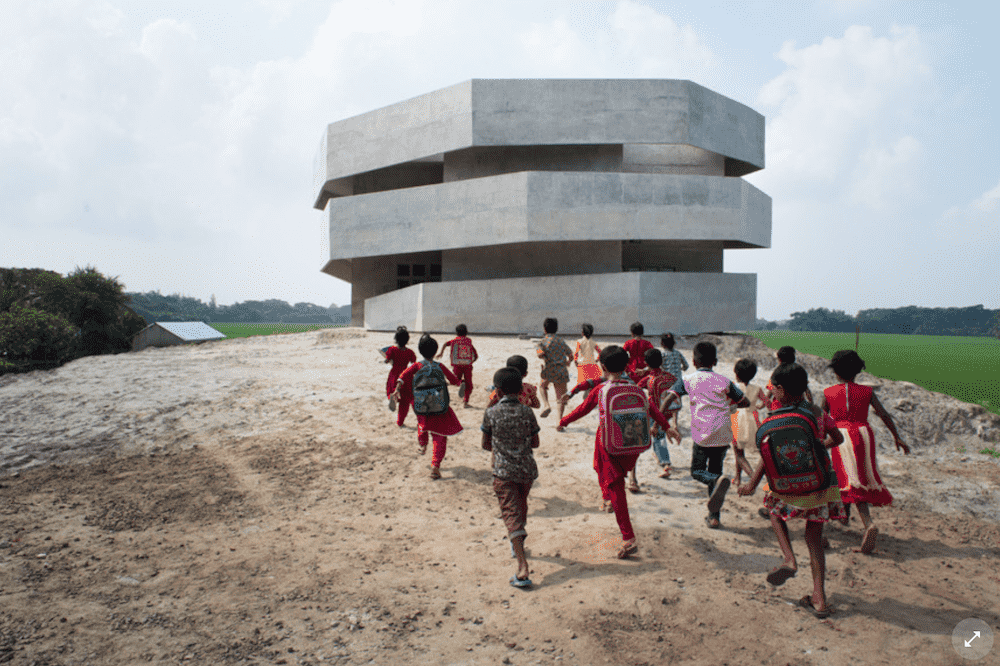
From a country facing the most pressing of climate induced disaster vulnerability, FRIENDSHIP is a social purpose organization that develops scalable adaptation solutions to strengthen the resilience of marginalised communities. With its working area consisting 100% of climate vulnerable population, the organization’s path has interesting lessons on adaptation. This article attempts to explore and connect the dots of their work from the beginning.
Bangladesh sits on the world’s largest delta, home to a rich and diverse playground of lives, between the Himalayas and its melting glaciers in the north, the Bay of Bengal in south, and hundreds of rivers flowing in between. This makes it the most exposed region to rising sea levels and unusual weather conditions, to climate and weather-related and geophysical hazards, due to its topography and geographical location. Nearly a third of the country is susceptible to tidal inundation and 70% is flooded every year during heavy monsoons. This situation strongly affects the ecosystems and the exploitation of the already restricted natural resources. The unpredictable, frequent, and multiple disasters, poverty, and lack of opportunities remain a threat to its population of 166 million. Therefore, the question of resilience of the communities becomes crucial. Twenty million people are projected tobe displaced by 2050 because of climate change(WEF).
Within Bangladesh, more vulnerable are the people living in the northern river islands, where an estimated 10 million people live. These people need to shift their homes from 20-40 times in their lifetime due to floods and river erosion. Also particularly vulnerable are the people in the southern coastal belt, who are constantly the subject of climate disasters and salinity. Five aspects keep on pushing these people away from a path of prosperity– the climate and impact of climate change, disasters, poverty trap that they find hard to come out of, lack of opportunity due to inadequate infrastructure and support service, and lack of life skills and knowledge which lowers their self-esteem, and therefore, dignity.
To design a proper intervention, Friendship goes through four steps to make sure the right thing is given in the right time, in the right amount and importantly in the right way. Starting with “vulnerability assessment,” it was at first apparent that the communities living in the shifting river islands healthcare as a top priority. Easily curable diseases were going untreated due to difficulty in travelling to mainland. This led to a health scenario that lagged behind the country average. For people living in nomadic islands, thus the ‘service package’ design had to incorporate this lifestyle and introduced hospital ships. Based on the needs, in due time two more tiers were added with the hospital ships as satellite clinics and community medic aides, increasing the inclusivity and access of the services. In the infrastructure step, a focus was given in making the service resilient to changes in the environment. Local resources were incorporated into the intervention with hundreds of community medic-aides and paramedics, midwives getting trained and performing important services for their respective locality. In the final step, the focus is on ‘mainstreaming’, with referral services being created to government medical facilities, other facilities, complementing the government in important immunization programs to have significant change at the field level. At every step, the prospect of the work was set in ambitious standards from the beginning. In practice, indigenous knowledge was welcomed while designing the adaptive solutions. Modern experts were also given their space to ensure the best possible service to be rendered.
Similarly, in an effort to empower to community to the next level, when the Education program was started, the initial vulnerability assessment indicated a few key issues. These were the nomadic nature of the islands, static schools not being able to withstand the erosions, and a lack of good teacher pool willing to live and serve the students in the islands. To tackle this, the ‘service package’ incorporated dismantlable schools, and ICT enabled lessons. At the infrastructure step, parent-teacher groups were formed to ensure continuity of schools even after erosion causes them to shift islands. Local resources were recruited and trained to serve as teachers and facilitators, and the community learnt how to dismantle the schools and relocate in times of crisis. As part of mainstreaming, these students are now actively being connected to higher education and job opportunities.
In terms of economic opportunity, at the first step, the vulnerability comes from lack of infrastructure, lack of adequate knowledge and tools to make good use of money while living in disaster prone area means savings are often wiped away. Thus the service packaging took this into account to introduce adult literacy programs, alongside climate adaptive agricultural training, and assistance, as well as familiarizing them with tools of savings tracking and using new technologies to increase income. At the infrastructure step, groups were formed at the community level to take major decisions with a more holistic vision, para-veterinarians were trained to help with cattle, clean solar power made accessible that led to increased productivity and life standard. For mainstreaming: Market linkage was facilitated, and connectivity with government’s social safety net program. Creating micro social entrepreneurs aligned with green technology at each level of service needs.
Asset vulnerability is the lack in long term facilities and know-how. The northern river island has been disadvantaged in this area due to the remoteness of the locations. Here the service package thus focuses on transferring know-how in resilient building, disaster preparedness mapping and training. For the infrastructure step, Friendship built flood-resilient raised cluster village, helped make raised house, cattle sheds, emergency boat transport during crisis. And lastly to mainstream, advocacy efforts are in place to share the knowledge of working in such areas and help take better steps for the communities .An example of such a step is that The Standard Guideline for Rural Housing in Disaster Prone Areas of Bangladesh was developed by the Housing and Building Research Institute (HBRI), in collaboration with Friendship.
With the cycle complete, a community has a distinct set of vulnerability which demands a different kind of intervention in the next phase of development. Quality delivery remained always an essential component of the way Friendship worked. This method of intervention design and implementation resembled the modern design thinking process, with emphasis given on the initial assessment, welcoming 360-degree input and then proceeding to lead with an appropriate option, keeping in mind the agility required to adapt to changing circumstances. This is how the program organically grew from a focus on Saving Lives, Poverty Alleviation, Climate Adaptation, to Empowerment. Today Friendship is reaching with their services to seven million people annually. The lessons from working in the most adverse conditions were embedded into the leadership and program implementation process. Enabling the organization to become important responders in natural disasters like Cyclone Sidr, unforeseen event like the COVID-19 pandemic, and a key player as the second largest national healthcare providers in the Rohingya camps after the 2017 influx.
Having the processed homed in for designing and implementing adaptation solutions, with the likes of hospital ships supported by satellite clinics and community medic-aides, ICT-enabled dismantlable schools, government service connectivity and legal aid — the scope for integrated approach was clear. It was evident that a community could be elevated much faster if an integrated solution was established with them, with a long-term vision in mind. This was revealed in a recent survey for the 2017 intervention in the river island Goynarpotol of Kurigram, where with an integrated approach, in 5 years there was remarkable change in the key indicators:
- Child Health: 93% mother perform exclusive breastfeeding of their infants (0-6 months) whereas baseline was 48.3%.
- Hygiene Practice: 94% people wash their hands before consuming any food whereas baseline was 28%.
- Birth Registration: 76% people perform birth registration of their child whereas baseline was 25%.
- Protecting Child Marriage: 96.5% people answered correctly about the legal age of marriage whereas baseline was 29.6%
- 93% of mothers believe their girls have no barriers to education compared to 82.3% in the baseline.
- More than half of the respondents (54.8%) are saving their money whereas two-thirds of the surveyed people in the baseline study mentioned that they did not save their money. Overall, the average amount of savings had been increased by 47.8%.
After the success of integration and expansion, the adaptation solutions are ripe for replication, which has been validated with the ongoing process of 5 more hospital ships that will launch, with integrated services tied to it, covering a far larger population than before. The social purpose organization is focusing on knowledge sharing and capacity exchange in a structured way, with collaborations with universities and publications at home and abroad.
With this record, the organization is now a champion of localization of funding, calling for increased local control of funds, of expertise, of decision-making capacity. With the whole world going through “the great reset”, where, according to the World Economic Forum, we are fundamentally changing the traditional context for decision-making. It is worth taking note of the way adaptation solutions have worked and evolved for people living in the forefront of climate impact. It is a modern design thinking challenge, and requires great empathy and commitment to values, to find the best service-infrastructure combination that can stand the test of time.
Originally this article was published on April 21, 2022 at Dhaka Tribune.
Runa Khan is a Rolex Laureate, Ashoka Fellow, and the Founder of Friendship SPO. Kazi Amdadul Hoque is the Senior Director. Strategic Planning and Climate Action at Friendship SPO.

